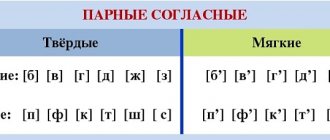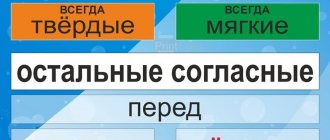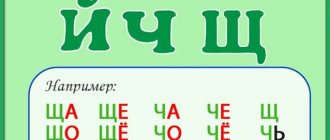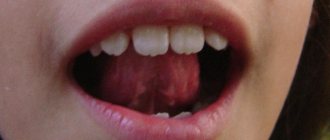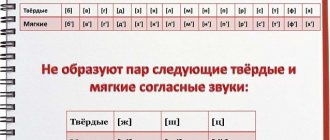There are two amazing letters in the Russian alphabet - b and b - they do not represent sounds! Why are they needed then? Let's talk about the importance of the soft sign in the Russian language, its function in speech and the rules of use.
The soft sign b, b is one of two letters of the Russian alphabet, the 30th in a row, which does not convey any sound. It serves to indicate the softness of consonants in writing. It just so happens in the Russian language system that all consonants can be divided into soft and hard.
History of the soft sign
At the stage of the birth of the great and mighty Russian language, our familiar soft sign was used as a very short version of the letter i.
Over time, the soft sign lost this purpose, but, like the letter i, it continued to soften the consonant in front. In the Cernovo Slavic dialect, the concept of using the letter ь is almost the same as in traditional Russian, with the exception of some details. Firstly, in Church Slavonic the soft sign, contrary to the rules and canons of the Russian language, is written after the hissing letters at the end of the nouns m.r. (bucket, guard). Secondly, the soft sign in Church Slavonic was written at the end of any short passive participles (see, hear).
In some cases, it was acceptable not to put a soft sign between consonants where it should be. For example, instead of the word darkness they could write tma, and so on.
A little theory
If you ask most adults what a soft sign is that is a dividing sign, then most of them will begin to hesitate and answer something like: “Well, this is a letter that should stand in the middle of a word and separate something.” This answer is partly correct, but in order to be more savvy in this matter, it is necessary to properly study the rules of the Russian language, as well as compare them with specific examples.
So, a soft separating sign is considered to be a letter that divides a word into two parts and stands before a vowel letter that denotes two sounds, for example, before “ya” [y'a] or “e” [y'e].
The peculiarity of the pronunciation of such words is that they are divided into two parts, each of which seems independent: “arsenic” [mysh'y'ak] - you just want to write “mouse” first, then put a space and write “yak”. The same applies to other words with a modified letter “er”: “article”, “blizzard”, “drinks” - regardless of what part of speech they are. The most important thing is that there is a vowel after it, and any consonant except “th” before it.
As for the location of the letter in a sentence, it should be in the middle of the word, with the exception of those positions when it stands immediately after the prefix. In this case, it is necessary to put a firm sign: “entrance”, “eat”, “drive up” - as in the previous case, the part of speech will not matter. However, the rule is relevant only when after the prefix there is the letter “i”, “yu”, “e”, “e”. In all other cases, a sign indicating softness will be written at the root of the sentence. In this way, you can even check the correctness of the morphemic parsing of a word.
Softening sign
In order not to confuse the “b”, which performs the function of separation, with the one that softens the sound, it is also necessary to understand the second part of the rule of the Russian language. So, a softening sign is the one that comes after a consonant and is used to soften the sound. As an example, we can cite a huge number of words:
- triangle;
- briefcase;
- plant;
- strong;
- rain;
- farrier and so on.
From the examples it is clear that this letter can stand far not only with hissing sounds at the end of the word: “quiet”, but also at the root if softening is required in it. Just as in the previous case, “b” does not denote a sound, but only gives softness to the letter that is in front of it.
It is important to consider that if the softening letter is at the end of the sound after the hissing one, then you should pay attention not only to the part of speech, but also to the gender of the word. As an example, it’s worth looking at two simple sentences: “I heard a child crying” and “Cry little girl, because sometimes it’s useful.” In the first case, the word “crying” is used as a noun in the masculine case, so you should not put a softening letter after the hissing one. But in the second case we are talking about a verb in the imperative mood, so you still need to put “b”. So just by looking at the presence or absence of a letter, you can also quickly find the necessary part of speech if the task requires it.
The role and meaning of the soft sign in Russian
The separative b is used in the root of a word between its parts. As already mentioned, in Russian ь has no sound, but performs three main functions.
Such as:
- An indicator of the softness of a consonant.
- Indicator of grammatical form (3rd declension feminine or infinitives answering the question “what does / what to do?”).
- Separating a consonant from the vowel that follows it.
Often, people know only one function - an indicator of softness, because of this, mistakes are made in words such as, for example, “article” or “blizzard”.
The role of one letter
The soft sign is one of the letters whose function has changed during the development of language. Once upon a time this letter was called “er” and denoted a very short vowel sound (reduced) - something between E and I.
As a result of the development of language, the sound denoted by the letter er disappeared. If this letter was stressed, it became E; if there is no stress in the middle of the word, it simply disappears (this is what explains the alternation with zero sound: stump - stump, for example); at the end of a word it began to denote the softness of a consonant.
The spelling of the soft sign b consists of observing 4 groups of rules:
1) soft separator: spelling;
2) the use of a soft sign to indicate the softness of consonants;
3) soft sign after hissing ones;
4) a soft sign in some case and verbal forms.
So, a soft sign can be an indicator of the softness of a consonant (day). May indicate a grammatical feature (for example, the 3rd declension of a noun: help, but cloak). Or it can be divisive.
What separates the soft sign?
The soft dividing sign is so called because it seems to divide the word into parts: the part after the sign is pronounced as if a new word begins from this place. If, for example, the letter I appears after the soft separating sign, it is read in the same way as at the beginning of the word: [ya]. This topic is studied in 2nd grade and usually does not cause difficulties in terms of spelling, but errors in phonetic analysis are not uncommon. Let's look at examples:
We recommend reading 76 refusals
Article – [stat'y'a´]
Drinks – [p'yo´t]
Blizzard [vyu´ga]
The vowels E, E, Yu, I after the soft separating sign each denote two sounds: e - [y'e], e - ]y'o], yu - [y'u], I - [y'a].
In what cases is a soft separator used? After any consonant before E, Yo, Yu, Ya, sometimes before I (if the sound [th] is heard). In this case, the consonant sound will not necessarily sound soft, since in this case the soft sign performs a different task. However, it is important to remember that this rule does not apply after prefixes. After consonant prefixes, before E, Yo, Yu, Ya, a hard separator is placed, not a soft one!
So, in accordance with the rule, the separating soft sign is written after the consonant before E, Yo, Yu, I anywhere in the sentence, except for the position after the prefix.
Soft sign to soften at the end of a word
Indicating the softness of consonants using a soft sign at the end of a word is possible only if the preceding consonant is not hissing. And in fact, after all, all hissing ones are either constantly hard and it is impossible to soften them, or they are always soft - then a soft sign is unnecessary.
In other words, a soft sign is written at the end of words where a soft consonant is heard, unless this consonant is sibilant or Y.
Let's give examples : stump, drumstick, wormwood, drops, huntsman, backwater.
Rules for writing words with a soft sign
A soft sign is never written at the absolute beginning of a word or after a prefix.
If a soft sign is used to indicate the form of a word (night, see, go), then it is written after the consonant at the end of the word.
As an indicator of softness, b is written after the letter denoting a soft consonant sound: letter, money, dictionary.
Games with letters and words “Games with letters and words” is a fun journey into the world of the Russian language! With the help of funny poems and illustrations, children will learn about upper and lowercase letters, ambiguous words, the rules of hyphenation, and also solve riddles and laugh along with the heroes of this smart and funny book! Buy
Designation of softness of consonants
- At the end of a word, the sign b is written after any soft consonant, for example: horse (cf. windows), coal (cf. corner), lantern, blow (cf. blow).
- In the middle of the word a soft sign is written:
- after a soft L , standing before any consonant (hard or soft), for example: sick, herring, boy, sawyer ;
- after a soft consonant standing before a hard consonant , for example: Kuzma, less, struggle ;
- between two soft consonants only if, when the word changes, the second consonant becomes hard, and the first remains soft, for example: in a request (request), Kuzmich (Kuzma), about struggle (struggle).
Examples of words with a soft sign
It is easiest to understand any rule using a specific example. Let's consider in which words the soft sign is used in the middle (root) of the word, and in which at the end.
In the middle of a word
- curious;
- serious;
- pedestal;
- computer;
- interior;
- barrier;
- bindweed;
- play;
- weeds;
- canyon;
- bouillon;
- nightingale;
- passerine;
- clerk
At the end of a word
- trees;
- feathers;
- family;
- studio;
- dress;
- arsenic;
- all-around;
- interview;
- fun;
- shreds;
- branch;
- rags;
- draw.
Now you know in which cases you need to write a separating soft sign, and in which not. At the beginning of studying this topic, it is better to pronounce the word in your head, and if you hear it as if it is divided into two parts, check it with the rules presented above.
Subsequently, the use of soft separating characters in words will become automatic and will no longer seem such a difficult task.
The word on the soft sign begins: example
The word on the soft sign does not begin
It's no secret that each letter of the alphabet corresponds to a certain sound. But in the Russian alphabet there are difficult letters that do not have a sound, and they also do not indicate it. One of these letters is the separating soft sign. When written, it looks like this - “b”. As a rule, a soft sign is located after a consonant, and nothing else, and is intended to soften it.
One of the requirements for writing a soft sign is that it cannot be written after prefixes, or at the beginning of words. That is why, in the Russian language, there are no examples of words beginning with a soft separating sign.
Test on the topic
- /10
Question 1 of 10The soft sign in Russian can
Start test
Hall of Fame
To get here, take the test.
- Natalia Barsukova
8/10
- Tatyana Kutukova
7/10
- Nadezhda Zaitseva
9/10
- Sergey Efremov
9/10
- Elena Skopina
8/10
Peculiarities of use in foreign words
The soft dividing sign (the rules of use are given in the next section) will not give two sounds to the letter in all cases. After all, if we take the word “battalion” as an example, we can see that the letter “o” has one sound of the same name, and the sign only gives the “n” softness. However, “ь” is still a separator, since it is in the middle of the word. However, this feature is observed only in those words that were originally borrowed from another language. Here are some interesting examples:
- pavilion;
- cotillion;
- canyon;
- postman;
- champignon;
- medallion;
- bouillon.
We recommend reading: The Psychology of Writing
For the Russian language, the use of “ь” before the vowel letter “o” is atypical, therefore, in almost all cases, in this way one can almost accurately determine where in the text a word borrowed from a foreign language is located. This can be called the unspoken fourth role of this interesting letter.
However, we should not forget that Russian spelling can change over time, so the list of borrowed words becomes more extensive every year.
Goal: to consolidate knowledge about the functions of the soft sign.
Tasks:
Corrective:
- consolidate students’ knowledge about the soft sign and its role in words;
- improve the ability to differentiate the soft sign in the functions of softening and separation;
- consolidate the ability to change singular nouns of the Nominative case into singular nouns of the Genitive case.
Educational:
- enrich the vocabulary and systematize children’s knowledge on the topic “Animals of hot (southern) countries;
- improve the ability to solve riddles;
- consolidate the ability to work with word patterns.
Educational:
- develop visual and auditory perception and attention, thinking, memory;
- improve language analysis and synthesis;
- develop phonemic awareness;
- develop fine motor skills of the fingers.
Educational:
- cultivate a culture of verbal communication;
- foster mutual assistance;
- cultivate a love for animals;
- improve discipline in class.
Equipment: playing field “Carpet Casket”, boat “Splash-Splash” Casket”, colored flags to the boat with words attached (example words: necklace, pancakes, pole, residents, animals, winter hut, grillage, goose, guest, family, pig , earrings, February, lantern, film, beans), manual “Multi-colored squares”, cardboard numbers on adhesive tape, pictures of animals and birds living in hot countries (example pictures: parrot, rhinoceros, jerboa, crocodile, giraffe, ostrich , zebra, antelope, turtle, monkey, lion, hippopotamus, tiger, elephant), narrow tape, scissors.
For each student: sheets of A-4 format with a picture of a ship, the “Yablonka” manual, checkered workbooks, pencils and pens, handouts (cards and sets of letters, circles and strips for creating a sound diagram of words), “Game visualizer with a marker” ", insert sheets.
Progress of the lesson
1. Organizational stage
In front of the children on the board there is a “Carpet Box” (˂Figure 1˃), in the upper part in the middle of the carpet there is a “Splash-Splash” boat without flags, behind each mast there is a colored square (behind the first mast is a red square, behind the second mast is an orange square, behind the third mast - a yellow square, behind the fourth mast - a green square, behind the fifth mast - a blue square, behind the sixth mast - a blue square, behind the seventh mast - a purple square). There are numbers under the boat, and at the bottom of the carpet there are colored flags, to which strips with words are attached. The remaining flags are located on the left outside the field (˂Figure 1˃).
Picture 1
The speech therapist welcomes the children, asks them to take their seats and check their readiness for class.
Students greet the speech therapist, take their places in the classroom, and check their readiness for class.
Speech therapist: Today we will travel. What can you go on a trip with?
Sample answers from children: by bicycle, on foot, by car, by plane, by ship, by train, etc.
Speech therapist: We will go on a trip to the island on a boat called “Splash-Splash”. But in order for the boat to float, it is necessary to attach flags to each mast.
2. Updating basic knowledge, repeating what has been learned. Development of sound analysis and synthesis, improvement of reading skills, development of visual attention and thinking
Speech therapist: Our boat has several masts, determine their number.
Student: There are 7 masts on the boat.
Speech therapist: Look carefully at the boat and the numbers, think and tell me how many flags there will be on each mast and what flags we will decorate them with.
Sample answers from children: on the first mast there will be 1 red flag, on the second mast there will be 2 orange flags, on the third - 3 yellow flags, on the fourth mast we will attach 4 green flags, on the fifth mast - 5 blue flags, on the sixth mast we will decorate 6 blue flags flags, and the seventh will have 7 purple flags.
Speech therapist: Now collect flags for each mast and first attach the flags with words.
Children take turns going to the board and under each number they collect the corresponding flags with words (˂Figure 2˃ and ˂Figure 3˃).
Figure 2
Figure 3
Speech therapist: Why do you think the words under each mast begin with a certain letter?
Sample answers from children: according to the first letter of the name of the color of each square.
3. Introduction to the topic of the lesson. Consolidating the ability to distinguish the functions of a soft sign, improving sound analysis and synthesis, visual and auditory attention, memory
Speech therapist: Read the words carefully, think and say which letter appears in all the words.
Children's approximate answer: the letter is a soft sign.
Speech therapist: Let's remember what we know about the soft sign.
Sample answers from children:
- a soft sign is a letter that does not indicate a sound;
- a soft sign in Russian serves to soften consonants if it is at the end of a word and between consonant letters;
- a soft sign will separate a word if it is followed by a vowel.
Speech therapist: To swim to the island, you need to write down these words correctly (put a sheet of paper with a picture of a boat and a pen on the desk in front of each child). Look at them carefully again and remember (children look at the words and remember, then the speech therapist covers the words on the carpet). Now I will dictate the words in order, and you write them on the masts of your boat. Dictates words, and children write them on the masts of boats.
Speech therapist: To find out which of you sailed to the island on a boat, you need to check the words you wrote.
Next, the speech therapist opens the words, and the children compare the notes with the words on the carpet chart. In place of the mistake made, a hole is made with a pencil on the sheet with the boat.
Speech therapist: Only those guys who made no more than 4 mistakes were able to swim to the island. Now find and read words in which the soft sign performs only the function of softening.
The children's exemplary answers are listened to.
4. Application of theoretical principles when performing exercises. Development of language analysis and synthesis. Development of phonemic awareness, sound analysis and synthesis, thinking, fine motor skills of the fingers
Speech therapist: You and I have sailed to an island where unusual fruit trees grow. These are apple trees with letters. Using laces, make up 2 words with a soft sign and name them.
The speech therapist distributes the “Apple Tree” manual to each child (˂Figure 4˃).
Figure 4
Children thread a cord through the holes and twist it around the desired letter, then make words with a soft sign from the letters and name the word (˂Figure 5˃).
Figure 5
5. Application of theoretical principles when performing exercises. Development of visual attention, thinking, vocabulary, sound analysis and synthesis, consolidation of the ability to solve riddles. Improving graphomotor skills.
Pictures with animals and birds living in hot countries are attached to the board.
Speech therapist: A lot of animals and birds live on the island. Look at the pictures and name them (˂Figure 6˃).
Figure 6
Children take turns naming the pictures.
Speech therapist: Who did we see on the island?
Sample answers from children: we saw a parrot, an elephant, a zebra, a rhinoceros, etc. (based on pictures).
Then the speech therapist places a box with letters and stripes on the desk in front of each child and asks them to solve riddles.
Speech therapist: Now listen carefully to the riddles about animals that we also met on the island, but their images are not on the board. Guess the riddles and make up guessing words from the letters, and then divide the word into syllables for transfer. Think and say what function the soft sign performs in each guessed word.
Puzzles
With a very long tongue, Maybe he is familiar to you? It harms ants - He is an overseas……..anteater
They look very wonderful: Dad has wavy curls, And Mom wears her hair cut - What is she offended by? No wonder you often get angry at everyone's mother......a lioness
She is slender and long-legged, Has two beautiful horns, Lives in steppes and deserts, Feeds herself on grass and leaves. Everyone calls the car that way….. gazelle
6. Independent creative use of developed skills and abilities. Development of sound analysis and synthesis, memory, thinking.
There are cards and pens on the desk in front of the children.
Speech therapist: Every animal and bird has young. Let's remember and write down some of them.
Next, in turn, each student reads the word on the card, names and writes down the baby animal or bird.
Speech therapist: Underline words with a soft sign, determine what function it performs in these words.
The children's answers are listened to.
7. Generalization of what has been learned and its inclusion in the system of previously learned knowledge and learning skills. Development of sound-letter synthesis, visual attention, thinking
In front of each child on the desk there is an “Igrovisor” manual with insert sheets and markers (˂Figure 7˃, ˂Figure 8˃).
Figure 7
Figure 8
Speech therapist: Guys, our boat trip is coming to an end. To get back home, we need to remember and find 10 names of animals from distant countries in tables with letters. Read the words and underline them.
Children complete the task, one by one find and name words in the tables (˂Figure 9˃).
Figure 9
8. Summary of the lesson. Reflection
Speech therapist: Our journey has come to an end.
- What letter did we talk about today?
- What functions does this letter perform in Russian?
- Remember which words - the names of animals or birds living in hot countries - are written with a soft sign.
Possessive adjectives
Among the examples of “ь” there are often words that are formed by declension and placing possessive adjectives in indirect cases. However, it is worth remembering that this part of speech may not be inclined in all cases. Although in the Russian language you can still find several interesting words that will lend themselves to this rule, for example, “Cossack”. If you try to inflect a possessive adjective, you will see the following picture:
- nominative - Cossack;
- genitive - Cossack;
- dative - Cossack;
- accusative - Cossack;
- instrumental - Cossack;
- prepositional - about Cossack;
Particular attention should be paid to the dative, instrumental and prepositional cases, because it is in them that, in most cases, novice writers make common mistakes, simply forgetting that it is necessary to put “b”. However, it is worth understanding that not all possessive adjectives can decline, and even more so, the root will not always include the letter that must be preceded by “b”.
Other cases
The soft sign is used:
- in the instrumental case of the plural of some nouns (for example: children, people, four )
- the numeral eight in all cases (for example: eight, eight, eight );
- in the indefinite form of the verb : to carry - to tinker, to shave - to shave ;
- in the imperative mood of verbs (see Note 1): prepare, prepare, get ready .
- at the end of the following numerals (nominal and vin. case) five, six. seven, eight, nine, ten, eleven, twelve, thirteen, fourteen, fifteen, sixteen, seventeen, eighteen, nineteen, twenty, thirty ;
- before the letter O in some numerals : sextillion, quadrillion, quintillion, septillion, etc.
Notes:
(1) Pay attention to the use in the imperative mood of forms of a verb that has only two forms: the form of the 1st person singular. numbers - lie down and the form of the 2nd person, h. - lie down .
(2) There is a variant spelling of the following numerals: sextillion, quadrillion, quintillion, septillion , etc.
(3) Note: the nouns daughter, bone and whip are in the plural instrumental case. hours have the ending -yami ( daughters, bones, lashes ), and obsolete forms ( daughters, bones, lashes ) in modern language can only be found in phraseological units ( lie with bones, beat with lashes ).
(4) Remember: if the ending -nya is preceded by the letter l , then write a soft sign after it: bathhouse, bell tower, ironing room, smokehouse , etc.
(5) Remember the spelling of adverbs: exactly and colloquially before .
(6) Distinguish the spelling of suffixes -t-(sya ) and others, the infinitive from the suffix -t-(sya) of the form of the 3rd person of the present tense. Compare: She wants to study at the conservatory. studying there ?
(7) Pay attention to the spelling of the following words: that is (that is, namely), tush (musical greeting) and mascara (paint), thinner and thinnest , nanny and nurse .
(8) Pay attention to the peculiarity of the spelling of the word love . The common noun love in indirect cases loses the vowel o: there is no love, to love, about love. The proper name Lyubov retains this vowel in all forms: Young Blok spent a lot of time with Lyubov Dmitrievna Mendeleeva.
Exception words with a soft separator
In native Russian words, the separating soft sign occurs only before the vowels e, ё, yu, ya, i. But in foreign words (especially French) it can appear before the letter o:
- postman;
- bouillon;
- medallion;
- canyon;
- cotillion;
- battalion;
- pavilion;
- companion.
Let's remember! When transferred, the separating soft sign remains on the previous line: monkey-yana, curious.
Always hard consonants
Separately, there are sounds that are always hard. Let's consider what happens if after the consonants Ж, Ш, Ц there is a soft sign or vowel E, Yo, I, Yu, Ya:
Sound Zh
- E: wife, token, wish, woman, defeat, sacrifice, rod, location, muzzle;
- Yo: acorn, conductor, perch, rigidity, bile;
- And: life, jeep, spring, gin, siskins, accommodation, fat, belly, skis;
- Yu: juri, julienne;
- L: trembling, lies, youth, husbands, wide open, harness, whim, rye, gun.
Sound Sh
- E: neck, wool, petition, crash, sheik, rank, duchess, husk, rogue;
- E: silk, whisper, stew, wool, millet, lattice, cheap;
- And: tires, expansion, width, firmware, awl, screen, error, silence, rosehip;
- Yu: parachute, brochure;
- L: mouse, nonsense, luxury, brooch, silence, wilderness, retouching, bald spot, mascara.
A little about the transfer
How to hyphenate words with a soft sign in the middle of a word? This is worth considering separately. Words with a soft sign in the middle of a word often cause difficulties when you need to move the word to another line. And there are many mistakes of this kind made in the texts.
Words with a soft sign in the middle are hyphenated as follows: first, you need to divide the word you want to hyphenate into syllables. We remember that, as many vowels in a word, there are as many syllables.
Step 1. Example: oh-no-me.
It is important to remember that when transferring a word with a separating soft sign to another line, you cannot separate the soft sign from the consonant in front - the transfer must be carried out only with it.
Step 2. Example: monkey-yana (example of correct transfer).
An important detail: if a soft sign is located at the end of a word, it cannot be moved to another line.
Incorrect example: mother-in-law, love, bear.
Correct example: father-in-law, love, honey.
When hyphenating, you cannot leave one letter on a line. This rule applies not only to words with a soft sign in the middle of the word, but also to any others.
Separating ь and ъ sign: cards
Card 1
1.Copy down the sentences, insert the missing letters.
Streams run from high mountains. Sparrows chirped loudly in the shady forests. Solov sing well in the collective farm gardens... The driver presented the documents to the police officer. An immense steppe spreads out before the eyes of tourists. Departure for the camp was scheduled for early morning.
2. Insert ъ where necessary. Select consoles. Underline the letters after ъ.
In...driving into the city, on the wall there is an announcement, a fox..and traces, show...your documents, once...found a comrade, enter the entrance, once...clarified the task, angry...furious beast, crane...you ...driving from the city, the vast steppe.
3. Make a phonetic analysis of the word jam.
Card 2
1.Copy down the sentences, insert the missing letters.
We are watering flowers today. Our whole family went out into the garden to water the tree. Deer...and antlers are highly prized. The children put edible mushrooms in a basket. The logs on the d..r..withered area..stu..moved apart. The worker presented his pass to the inspector.
2. Select words with the same root with the indicated prefixes for these words. Select consoles.
Riding (from-, under-, on-, once-, you-, for-). Ate (by-, with-, about-, under-, once-, re-).
3. Do a phonetic analysis of the word trees.
Card 3
1.Copy down the sentences, insert the missing letters.
Sad..thoughts..I dreamed in the head of the old postman..he. No amount...separated the field from the garden. A strong wind in the south delayed travelers. The detachment listened carefully to the announcement of...the departure to the city. Cross-country skiing was announced on Sunday.
2. Write by opening the brackets and inserting the missing letters. Select consoles.
Uncle Il. I went on a (s) trip and took me (to) g..stay with my grandmother. A car drove up to the driveway. We (you) got on the road and an hour later (in) we went to the city.
3. Do a phonetic analysis of the word drive.
Card 4
1.Copy down the sentences, insert the missing letters.
He did the mail...he brought magazines. A squadron of aircraft took off from the airfield. The Christians loved the freedom of the steppe..e. Wormwood..I froze...very slowly. The dungeon was dark and damp. By sunset the sky cleared. The tousled birds sat on the tree. The grey-haired little boy quickly went down the hill.
2. Write down in two columns the words with ь sign and with ь sign indicating the softness of consonants.
Sick, gun, spear, I'll take, birds, letter, nightingales, trees, night, boy, autumn, pebbles, ants, happiness, life, blizzard, slice, finger.
3. Make a phonetic analysis of the word monkey.
Card 5
1.Copy down the sentences, insert the missing letters.
Red ants..and great friends of the forest. Ants...and one anthill per day...eat more than thirty thousand caterpillars. On long journeys, passenger trains hum. Shrinking from the cold, the puppy lay in the beech. The l..sleepy field was shrouded in a thick fog.
Write down words with the same root, indicate the root.
2. Write phrases, changing the meaning of the words in brackets.
(Fox) fox hole, (bird)……………………………. feather, (wolf)………………… footprints, (dog)………………………. kennel, (goat)………………………….. milk, (bear)………………………… paw, (hare)………………………….. hat, (squirrel)………………………………. skin
3. Make a phonetic analysis of the word ants.
Card 6
1.Copy down the sentences, insert the missing letters.
Because of...the rain..I couldn't drive the car...to the entrance. The branches of the old trees were crooked and thick. The counselor once..clarified the mate's plan. In..sleeping birds make..nests, and the..n..s..give their native lands. At the old place, the logs moved... away, and the cars went around.. around.
2. Write down in two columns the words with ь sign and with ь sign indicating the softness of consonants.
Boy, feathers, health, chirping, pouring, letter, family, polka, sons, cereal, big, minx, tenants, housing, ice floe, streams, feathers, day, mill, skates, coals, dust, ring.
3. Do a phonetic analysis of the word feathers.
Card 7
1.Copy down the sentences, insert the missing letters.
The tourists drove away from the city and drove up to a stormy river. The bus drove into the village, the children rushed into the arms of Aunt Tat..yana. A big bad... I was standing on the driver's seat. The runners of the sled are made of metal. A rapid stream of water of incredible force rushed through the gorge.
2.Read the proverbs. Insert a hard or soft separator. Select consoles.
1. All this...I am together, and my soul is in place. 2. In order to eat a fish, you need to fly into the water. 3. They meet you according to your payment, but you see them off according to your intelligence. 4. In winter, I would eat a fungus, but the snow is deep. 5. The bird is red with feathers......and the man is learned......eat. 6. They kill the wolf not because he is gray, but because he ate the sheep. 7. From idleness..I am not happy..I am. 8. What I came with, I left with. 9. We went to the forest to pick...edible mushrooms.
3. Make a phonetic analysis of the word health.
Card 8
1.Write by inserting the missing letters.
Z..ma announced..ina in..a dream. The pr..l..tel wind..r, s.brought menacing clouds. They did not let the sun's rays hit the ground. V..sleep sent m..l..to the grass..warm drops of..rain. Z..ma froze them.. The kidneys on the... roars... shrank. Z..ma pinched them with her pussy. Mixed rain with snow, thunder in the autumn with the south. The enraged z..ma tried to strike at the very heart in..a dream, but couldn’t see..it.
2.Write down 5 words in three columns:
- with a separating soft sign;
- with a soft sign - an indicator of the softness of the consonant;
- with a solid separator.
3. Do a phonetic analysis of the word sparrows.
Card 9
1.Write by inserting the missing letters.
In the summer I started eating apples. The old miner's house was clean. A battle is being waged against the dirt and dust in the room. The crane worker explained to the guys how the crane works. At the entrance...a small kit...shrinked...from the cold..yes. An angry wave of water rushed along the length. By sunset the sky cleared, the trills of the sun were heard..in..i.
2. Divide the words into groups.
Sem..ya, in..drove, bul..on, in..et, in..drive, in..south, postman..he, in..yun, shrank..shrinked, announcement, r..i, Il..ya, angry..furious, gun..e, Dem..yan, from..yan, medal..he, bird..i.
3. Make a phonetic analysis of the word linen.
Card 10
1.Write by inserting the missing letters.
Girls at labor lessons sew dresses for dolls..i. The D. horns were blocked, the cars went around. The father explained to his son the structure of the bicycle. There is a spring under a high mountain. Natal..I drink cold, clean water. The sparrow..and sat on the tree..and lay..lived on the wings..I. The boys found a hedgehog under an old fir tree. The cold made my...b...sh...shrink. Caterpillars eat the l..l..dead leaves..I am an apricot.
2.Insert into sentences suitable words with separators ъ and ь.
1. Sasha ………………… pie. 2. To the house……………………………….. car. 3. In the spring, …………………………………… flowed along the paths. . 4. Ilya loves foam with …………………. 5. Birds…………………. . nests on …………………………………. and bushes. 5. It rains often …………………………….. in the fall.
3. Make a phonetic analysis of the word family.
Card 11
1.Write by inserting the missing letters.
Dar..I hung the white..e in the door..re. Mom works in a t..e., she pays..e. With joy...on this holiday...our capital is Moscow. The wind ruffled the boys' hair. Dry, shriveled leaves... collapse and fall helplessly to the ground. In the calm, quiet twilight we went out to the railway crossing. Not far away, a rapid mountain stream roared with incredible force. Tousled jackdaws rushed along the wind. There is...a stitch that leads the traveler into the desert. If an eagle often beats its wings, then its wings break.
2 Write, opening the brackets.
1. (C) ate (c) the squirrel jumped. 2. The guests (c)ate a delicious cake. 3. The worms (pod) ate the roots of the cabbage. 4. The hare sat down (under) eating. 5. The car (under) drove (to) under (drive).
3. Make a phonetic analysis of the word blizzard.
Card 12
1.Write by inserting the missing letters.
Pine trees bathed in sunlight adorned the lawn. What does not pour out of a cup is what is not in it. A tall bush grew along the old fence. At night there was a strong frost... Delegates from all over our country came to Artek for the congress. The sonorous songs sing over the very unknown ones. Know how to distinguish edible fruits and berries from fruity ones. The radio announced that the plane was boarding. Back in the past... we went to the city... The boy explained to his friends how to... get to the park.
2. Come up with and write down 3 words of different parts of speech with the separator ъ with these prefixes: s-, under-, ob-, raz-, v-, ot-.
3. Make a phonetic analysis of the word housing.
Card 13
1.Write by inserting the missing letters.
Later in the fall...the squirrel changes his red dress to his gray winter coat. The detour was laid along the river bank. Residents greeted the announcement of the trip with joy..but. The court..I announced the results of the competition. Storo.. Il. I knew the hare.. and the fox.. and the tracks well. Cross-country skiing was announced on Sunday. The squirrel...and the skins were chalked...in the shade of the trees.. At Lukomor..I'm blown..green.
2.Write, dividing the words into 3 groups. Give each group a name.
Cotton, s.ezd, happy, in.south, teacher, boy, pal..to, white..e, ant..i, guest..i, tree..i, in..south, rise..em, lights..ki, postman..he, volume.. volume, liver..e, bag..capacity, letter..mo, boy..chik, under..drive, s..ate, monkey..yanka, rain... .
3. Do a phonetic analysis of the word roots.
These task cards for practicing the spelling of the separating signs b and b can be used at home, as training exercises, or by a teacher in the classroom to test students' knowledge.
I hope that this material will be useful to you.
I also recommend that you familiarize yourself with the Russian language cards for all spellings.
Sincerely, Olga Naumova
How not to make a mistake when writing a soft sign in the middle and end of a word?
A soft sign at the end of a word is needed to soften the consonant in front.
We recommend reading: The complete version of time management for writers and freelancers
Examples: coal, salt, moth, tulle, pain, daring, calm, scrap, teacher, password.
The sounds ch, zh, sh, according to the canons of the Russian language, cannot be soft a priori, but in some cases a soft sign can be placed after them. It does not soften the preceding consonant, but is needed to preserve the grammatical form. Let's see in what cases this can happen:
- Feminine nouns (rye, quiet, mouse).
- Verbs in all forms (drain, protect, build, wash).
- In adverbs ending in ch and sh (backwards, completely) and in one adverb ending in w (wide open).
When you don’t need to put a soft sign after hissing ones:
- Masculine nouns (reed, garage, guard).
- Short adjectives (good, nice, fresh).
- Adverbs with except wide open (unbearable, married, already).
- Feminine nouns in the plural of the genitive case (pears, clouds, heaps).
Soft sign after sizzling
After the hissing ones the soft sign is written:
- in nouns of the feminine singular (noun and noun case), for example: speech, silence, rye, mouse, daughter, night;
- in the imperative mood of verbs : appoint, cut, eat, appoint, cut, eat ;
- in the indefinite form of verbs : take care - take care, cut - get a haircut ;
- in the 2nd person singular of verbs of the present and future tense, for example: you carry, you carry, you throw, you rush, you rush, you fiddle;
- in adverbs , for example: unbearable, completely (exceptions: already, married, unbearable );
- in particles you see, that is, only, you see (exceptions: already, already ).
Algorithm for self-test
In order to learn to correctly distinguish words with dividing marks (hard and soft), as well as softening letters, you should analyze several examples in practice, using a certain algorithm of actions. Here is a short guide that will be especially useful for beginning writers and middle school students:
- Write the word down on your notebook and pick up a pencil.
- Take a look at the characteristics of the word and its role in the sentence.
- Determine the part of speech using a question and the meaning of the construction.
- Carry out morphemic analysis, trying to modify some or other parts (root, suffix, prefix).
- Be aware of possible exceptions.
- Draw conclusions and write the correct letter.
As practice shows, students remember the rules much faster if they have completed some tasks designed to reinforce the material. So it’s worth examining one or two interesting examples in practice using the described algorithm of actions. You can even do the exercise with two words at once to make it more interesting: “exhausted” and “hookah”:
- Having written out the examples in a notebook, you must first determine the part of speech. The first is a participle, the second is a noun.
- Next, you need to analyze the composition to determine where the words end and the prefixes begin. In the case of “hookah”, everything is more or less simple - the root is the entire word. But the first example can cause difficulties. Although it is enough to remember what participles are formed from - “to ride” - that is, the root is “ezh” (alternation occurs, then comes the standard suffix “enn”, and the prefix “iz” comes in front).
- According to the rules, it is necessary to write a hard separator in the first example, and a soft one in the second.
- Words are also no exception.
Finding the separating “b” is not as difficult as it might seem at first glance. The most important thing is to remember what the rules say and also practice as much as possible with different examples. In this case, even the most cunning designs will not be able to confuse the writer.
Spelling with examples
Most of the questions that students have about the use of spacers are related to which one should be written in a word. After all, if after “ъ” or “ь” there are letters “е”, “е”, “и”, “я”, “у”, then you can easily make a mistake in their spelling. Here are some examples: “cognac” and “ad”. And if with the first case everything is more or less clear (it’s somehow unusual to use “b” in it), then with the second, a number of difficulties will certainly arise, because here “b” can look quite good.
To check the correct spelling of words, it is not at all necessary to look for spelling tables and try to find the right word. It is enough to simply conduct a morpheme analysis and pay attention to the part in which the letter of interest to the student is located. Only in this way will the student be able to understand in what cases a soft sign is written. Here is an extract from the rules:
- “Ъ” will be placed in cases where it is located immediately after the prefix, and the root begins with the letter “e”, “yu”, “ya”, “e”, “i”. Particular attention should be paid to this example: “super interesting” - precisely because after the prefix “over” there is no “ъ”, the root begins with the letter “i”, not “s”. Thus, using the same rule, you can check the spelling of words for a wide variety of tasks.
- “b” is written when it is at the root of a word or before a conjunction or ending: “bird-like” (nests, for example). Even though the root of the word is "birds" (alternating with the sound "ch"), the separating letter will still refer to the stem. This should be remembered not only in cases when it is necessary to carry out morphemic analysis, but also when it is necessary to move a word from one line to another. It is important to remember that you cannot separate “b” from the root, so the ending or suffix is moved down.
- Well, as for words of foreign origin, their spelling and the order of letters should be checked using a special dictionary. After all, more and more not only nouns, but also verbs that were borrowed from other languages began to appear in the Russian language. A striking example is the word “collect”, which is used without any separating letters at all, although according to all the rules there should have been a dividing solid sign.
However, in any case, you should start performing this or that exercise with morphemic analysis, since this is an excellent option for determining which letter should be placed in a word (or, in this way, you can carry out testing work).
To understand which part of the word the sign belongs to, you should try to modify the root, remove the prefix or add another suffix. However, do not forget that some letters may alternate - this makes the task very difficult for novice writers.
